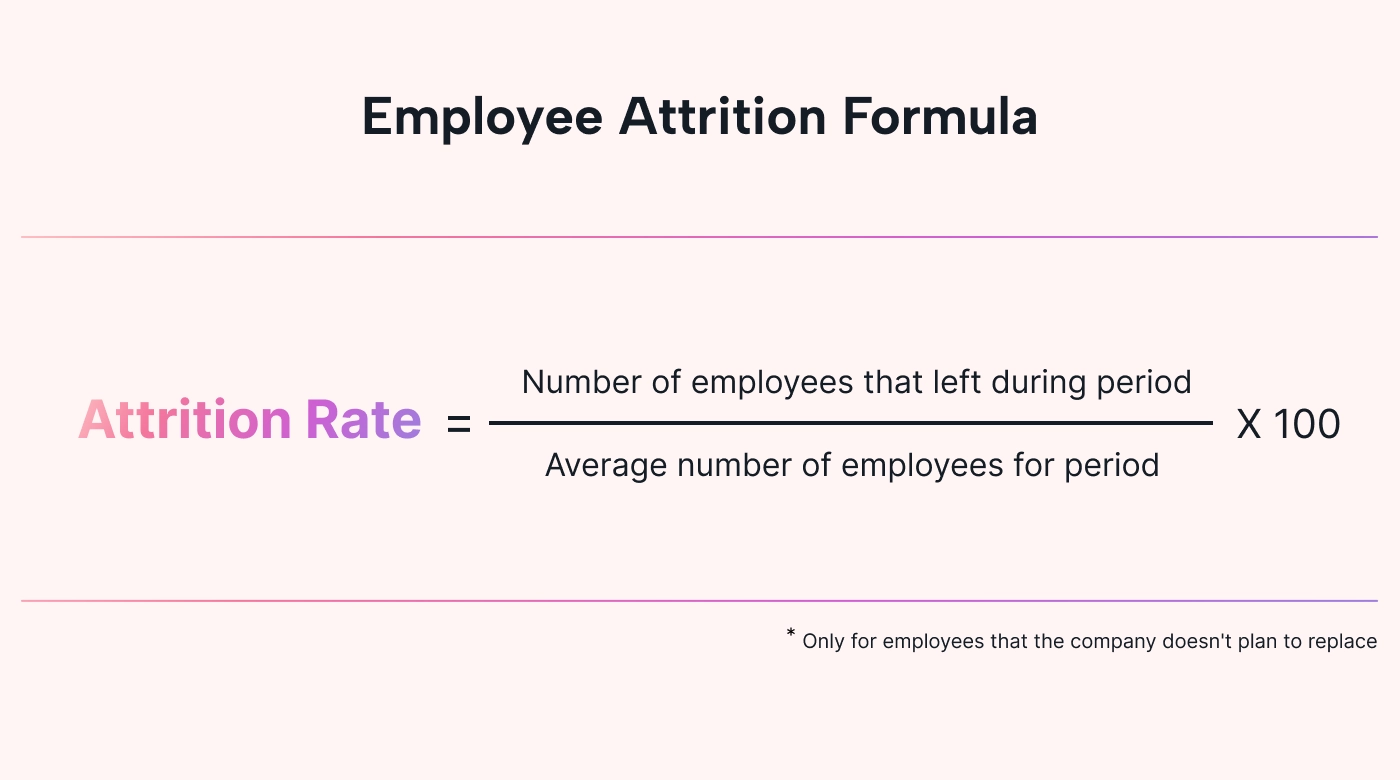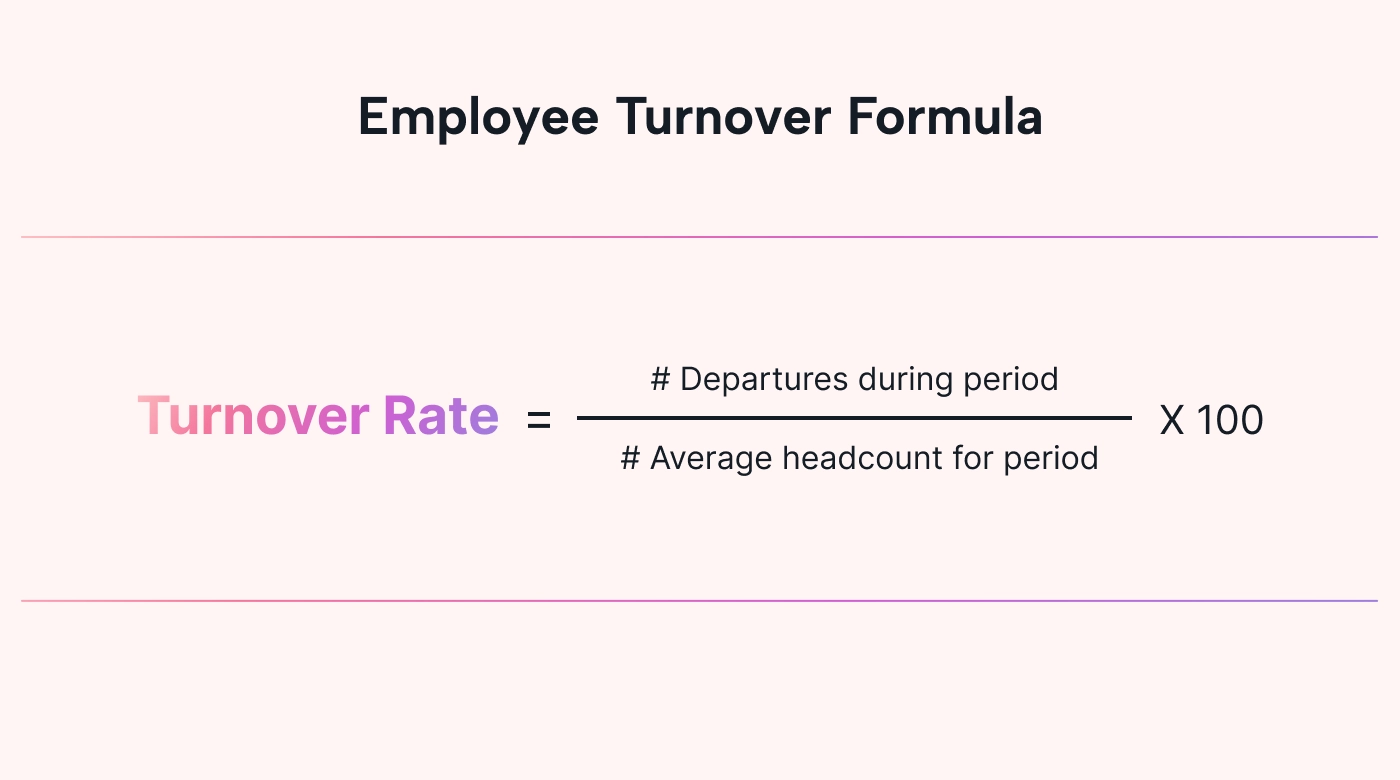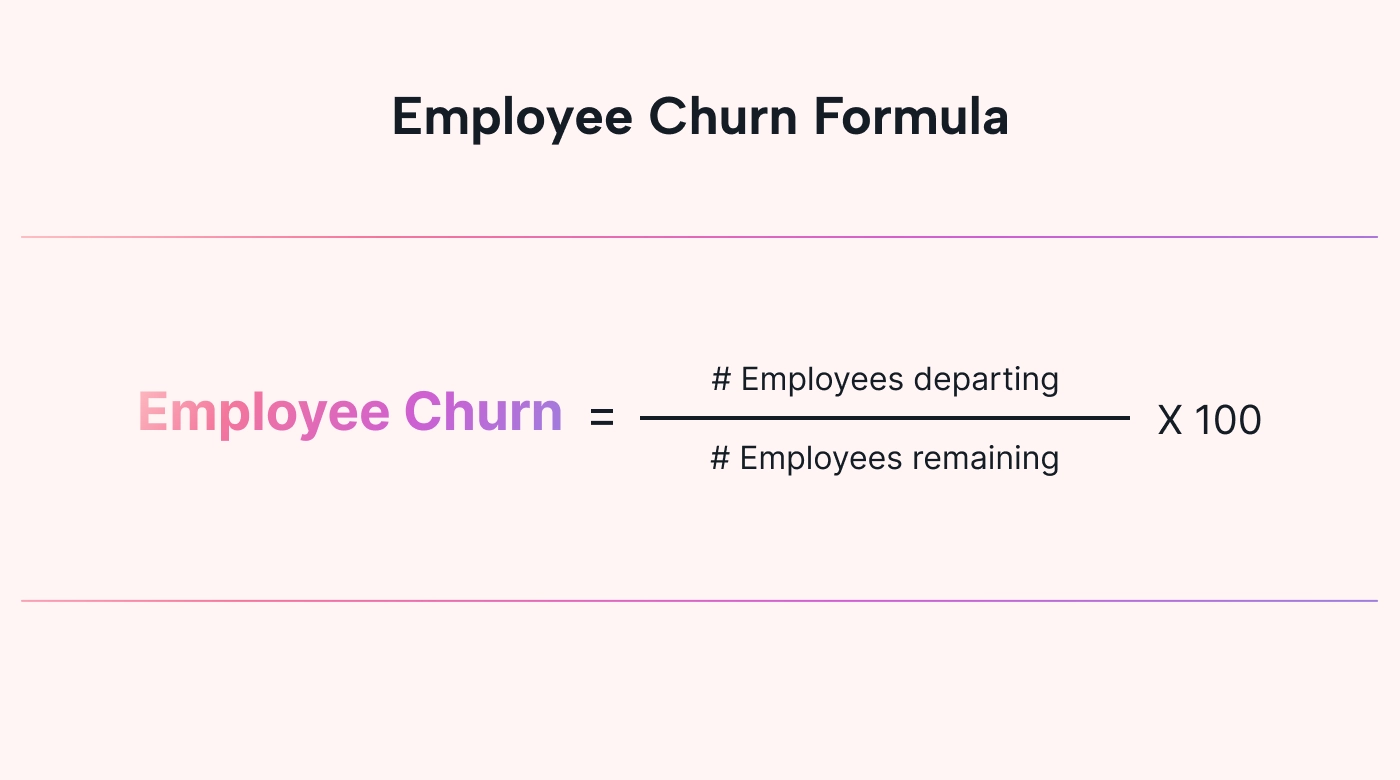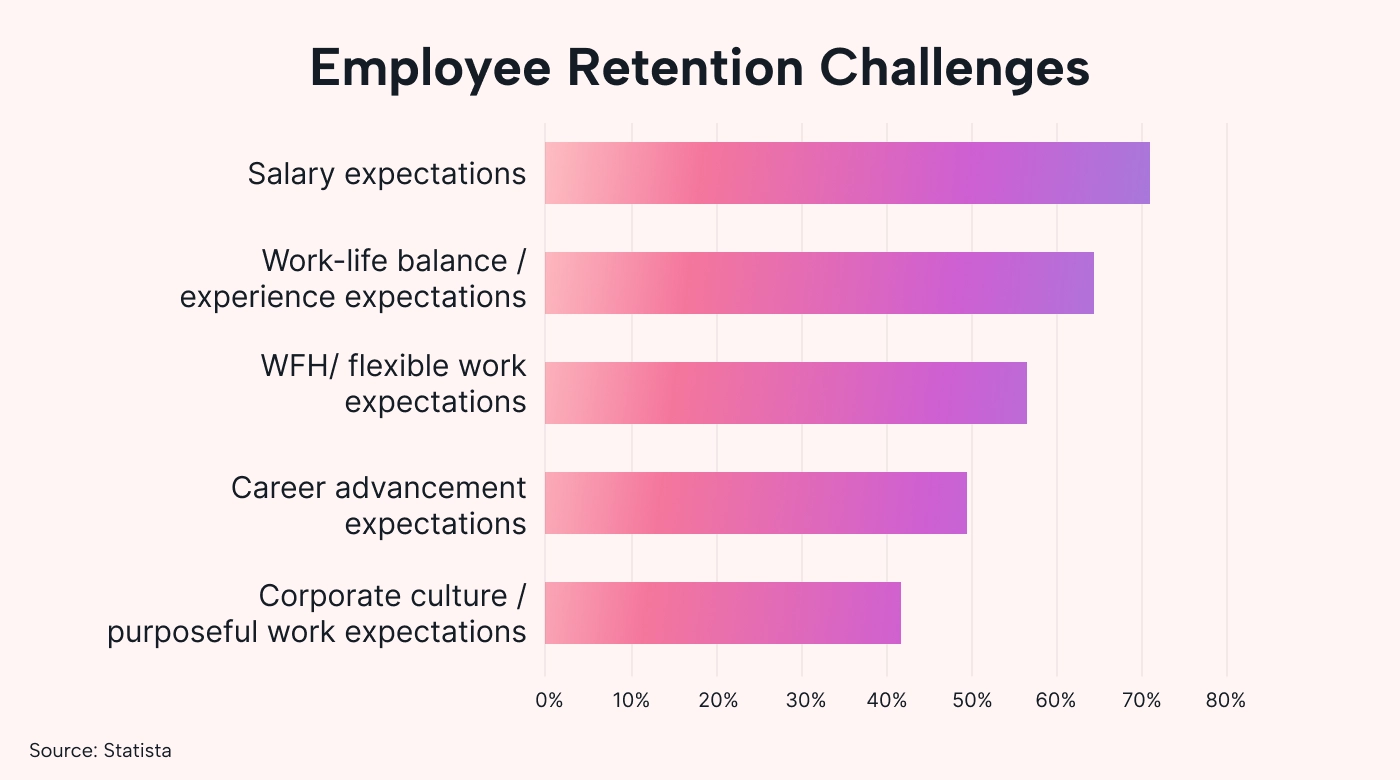Do you love your employees and strive to create the best possible work environment for them?
Well done, and keep up the good work.
Sadly, that won’t stop employees from leaving. No matter how good the work conditions are, some of your people will always leave.
Employee defection is something you have to deal with and try to minimize. Too many people jumping ship means you have to spend time and money hiring and training replacements.
According to Gallup, the cost of replacing an employee can range from half to twice that employee’s annual salary. And that doesn’t even count the lost revenue the old employee brought in or the new employee’s salary.
Churn may be good when it comes to butter – not so much when it comes to your company. So what exactly is churn, and what are the key metrics associated with it?
Understanding employee churn: how it’s different from attrition and turnover
Employee churn, turnover, and attrition are used interchangeably but they’re not the same.
Employee attrition is when someone leaves voluntarily, and the business doesn’t plan to hire a replacement for that role. An example is someone who decides to leave or retire, and the business simply spreads the work to the remaining team members.
Attrition rate is calculated by:
 |
Employee turnover is when someone leaves the company and there are plans to hire a replacement. Turnover can be voluntary or involuntary, and both can speak to deeper issues in the business.
Voluntary turnover occurs when employees resign, while involuntary turnover happens when the company terminates them.
For instance, a high voluntary employee turnover rate can mean that the company culture isn't great, and you need to determine why they’re leaving. A high involuntary turnover rate can mean you’ve been hiring the wrong people, or at least that the hiring process wasn’t done well. It might be time to revisit the recruitment process.
Employee turnover rate is calculated by:
 |
Employee churn is a combination of attrition and churn. It accounts for employees who leave the organization within a certain period, regardless of whether they fall under attrition or turnover (whether or not you plan to replace them.
Employee churn rate is calculated by:
 |
All these metrics represent the different scenarios under which employees leave an organization.
You already know having too many exits is a major problem. But why is it a problem – how exactly can this impact your business?
Why should businesses be worried about high churn rates?
A recent survey shows that the average turnover rate among US businesses in 2023 was 17.3%, down from 24.7% the previous year.
Some reasons businesses should be concerned about high churn rates are:
1. Costs
The cost of replacing an employee is high. Companies incur a “burden rate” cost, including training costs and payroll taxes.
A few costs included in the process are:
- Advertising the role
- Time and cost of an internal recruiter
- Time spent reviewing resumes and other checks
- Time and cost conducting the interviews
- Cost of background checks and drug screens, if applicable
- Additional pre-employment assessment tests, e.g., medical tests
Once onboarded, you need to train them to get them up to speed with the workplace. In 2023, small businesses in the US (100 to 999) employees spent an average of $1,420 in training expenditures per hire.
If you’re looking to reduce operating costs, reducing churn is a good place to start.
2. Loss of productivity
New hires need time to start firing on all cylinders.
Typically, a new employee takes at least six months to start delivering at 100% productivity. This burdens the business as they pay their full salaries during this time. And they probably aren’t yet contributing their full share of business either.
This slows down things within the business, especially if there are many new hires. And especially if your most valued employees are helping bring them up to speed.
3. Impact on employee morale
Too many employees leaving affects the morale of those staying, leading to decreased motivation.
There’s a sense of camaraderie within the business for employees who’ve been there for a while, giving them the morale to keep going.
However, when many people leave, it communicates to those staying that something is wrong or that there are better opportunities elsewhere. At least it certainly makes them wonder what’s going on.
4. Loss of institutional knowledge
Each person who leaves the company goes with bits of institutional knowledge from their experience there, which can't be replaced.
While new hires bring fresh ideas and perspectives, having people with experience within the company is key. They'll help assess the new ideas and keep the business from repeating mistakes.
Always try to keep a healthy balance between the old guard and new blood in the business.
Causes of high employee churn
A recent survey indicates that the top issues that lead to employee churn are increases that don’t come, burnout or too little time for friends and family, flexibility to work from home or at least reasonable schedule flexibility, few or invisible opportunities for promotion or advancement, and toxic or at least uninteresting work environment.
We’ll break these and others down.
1. Poor organizational culture
A bad workplace culture full of discrimination, sabotage, toxicity, and harassment will drive valuable employees away. No company wants to create a toxic work environment, but it happens due to multiple factors.
A key one is poorly trained people managers who cause unnecessary stress in the workplace. The result can be people leaving their managers and not the company.
A few questions to ask yourself when assessing company culture are:
- How openly and often do executives communicate with employees?
- Do workers feel respected and supported in executing their tasks without micromanagement?
- Do team leaders trust employees to deliver?
- Is there a culture of inclusion?
- Do employees understand and support the company goals and objectives?
Building a positive workplace culture isn't easy, but leaders can make it work with the right strategy and initiatives. This way, talented individuals will feel valued, supported, and respected and ultimately want to stay longer.
2. Lack of career advancement opportunities
Do you have a career growth program that’s structured and clear to employees? Most people want to grow and need to be in an environment that supports this ambition.
Employees will leave if they feel like they've stagnated and see no opportunities to grow to the next level career-wise.
As a business owner, invest in continuous learning and skill development to support your employees.
Additionally, support the best talent to grow within the business so that this serves as a testimony that growth is possible if you show up diligently.
3. Poor compensation and benefits package
Compensation below market value will make employees leave and look for jobs in companies that appreciate their value and pay them well. A recent survey shows that annual salary expectations were the leading reason businesses struggle to keep employees.
In addition to salaries, do you offer benefits such as health insurance, life insurance, retirement plans, and other programs that improve well-being?
When employees feel that the compensation and benefits don’t meet their needs or are less than competitors offer, they’ll move.
4. Misalignment with company values
If the company’s values don't align with an employee’s, they'll eventually leave. This challenge should be addressed from the onset, that is, during the hiring process.
While it’s inevitable that someone not aligned with your values and vision will leave, always communicate these, and ensure it's clear how everyone plays a role in helping to achieve the vision.
5. Job insecurity
Businesses that are unstable and have constant restructures and layoffs will drive employees away since no one wants to continuously deal with uncertainty.
Who wants to work in a place where they’re never sure what the next month will look like?
Uncertainty leads to anxiety, and this keeps employees from delivering at optimal levels. Nearly every employee expects some assurance that they won’t just wake up one morning without a job if they’re performing well.
6. Personal reasons
Some employees leave a business for personal reasons such as a career change, relocation, family obligations, or other interests.
These are outside your control, but it's important to understand the causes of churn that you can control. And be prepared and understanding when someone leaves for reasons you can’t.
How to reduce employee churn in a company
A few tips to improve employee churn are:
1. Improve the hiring process
The first step to reducing employee churn is to hire the right people to begin with. Constantly hiring the wrong employees will keep your churn levels high, which isn't sustainable.
You need to address the issue at source, right?
Before hiring, think about and model the right employee for your company's culture, values, and setup. Are you looking for certain skills and attitudes? How easy will this person find it to gel with the existing employee base?
Additionally, look at the kinds of people who enjoy working at your company and use those to derive the right traits you need to look for.
From here, review your hiring process and train your recruiters to identify the ideal candidates.
A solid hiring process will reduce the risk of bringing in the wrong fit. You’ll learn to hire employees who’ll be happy to work with and for you.
2. Offer competitive compensation
Businesses always try to reduce their costs, including labor, but to retain talent, you need to offer a competitive compensation package.
This doesn’t mean you need to overpay employees, but find smart ways to reward them, depending on your business situation.
First, ensure that you comply with FLSA guidelines (U.S. Department of Labor Fair Labor Standards Act, which guides wages and other practices ) if that applies to your company. From there, design a compensation strategy that'll make you a viable option for top talent.
Explore the three strategies — salary, salary plus commission, and straight hourly compensation — to see what works for different roles. Not everyone can be on the same plan; for instance, individual contributors like salespeople are best compensated using the salary plus commission model, which incents them to go above and beyond.
Consider taking a total rewards approach, where you bundle the salary with additional perks such as bonuses, medical insurance, and paid leave. These benefits give you a flexible and creative way to make your compensation package attractive.
3. Give clear opportunities for career development
Businesses need to constantly demonstrate to employees that they offer an opportunity for them to grow, or at least be recognized.
Who doesn’t like some TLC?
A good way to do this is by designing a structured growth program for different career paths that makes clear what it takes to grow. Also, support employees when taking some of these steps, for instance, through upskilling programs, job rotation opportunities, or allowing them to shadow leaders.
Have employees who have successfully gone through these programs be your ambassadors and celebrate their success stories.
4. Open feedback channels between employees and managers
No workplace is perfect, and there'll always be issues now and then. However, what defines a good workplace is how these issues are handled.
Always set up a structured way to channel feedback between employees, managers, and leadership. This allows you to bring all background conversations to the fore and handle issues as soon as they arise instead of waiting for them to worsen.
For instance, if your teams were fully remote and now you arbitrarily ask them to return to the office, most people would be disgruntled. However, with clear rationale and dialog, you’ll have a platform to gather feedback on this directive and eventually find a feasible solution like a hybrid work arrangement.
5. Address issues with management
Managers and leaders are the business’ ambassadors to employees. A bad manager doesn’t do the business any favors and, in many cases, will drive key employees away.
Empower the people leaders in the company to lead with empathy, communicate freely, and create a conducive work environment for employees. Do this by creating a training program to equip leaders with leadership skills.
Foster a corporate culture with psychological safety, and leaders are open to constructive feedback and having tough but constructive discussions.
6. Introduce employee engagement initiatives
Employees need to feel like they are connected to their workmates if they are to stay in a company for a long time frame. In addition, stronger employee bonds lead to more productive teams.
A business is responsible for creating avenues where employees can bond and engage outside work. Having frequent team-building activities is a great way to do this, and they can be done in many ways.
For instance, have an annual team-building offsite trip where employees go away for a few days to have fun and engage in activities that aren't work-related. Other smaller activities include work lunches, themed work days, market visits, and peer-to-peer learning arrangements.
7. Conduct exit and stay interviews
Do you understand why people choose to stay or leave your business?
Conduct stay and exit interviews, and you’ll find out.
Exit interviews are great since they give honest feedback. Doing this regularly will give you a sense of why people are leaving and allow you to address any issues within your control.
Stay interviews allow you to check out why some employees choose to stay and let you see the key positives you can dial up to increase retention.
Improve productivity and reduce your churn
A few employees will leave any business, but this doesn’t mean business owners need to be discouraged. There are multiple things within your control that you can do to make your business an excellent workplace for all employees.
One way is to leverage the power of technology and implement a tool that makes it easy to manage projects, collaborate, and be productive.
Check out Motion today and see how your operations are transformed. Its unique AI improves productivity by serving up project and non-project work in an optimized calendar for each employee.
With Motion, you can increase your productivity and your business performance – and, keep your employees happy, with lower churn rates. Remember, they’re not butter.
An expert B2B content marketing consultant and writer specializing in SaaS, e-commerce, and digital marketing businesses, Thomas Law focuses on driving traffic to your website, engaging your target audience, and increasing signups through content.





